|
5-2-6@¹ïƵÄÌrfIEJER[_[
Example N's approach to family history research N.writes: -
I had tried to start this research about 30 years ago but failed to get very far as I could not find the birth details of my two grandfathers and I had not much time to solve the problem, so I gave it up. In 2000, 3 years after the death of my parents, my brother found a document in my fatherfs photograph album - a document we had never seen before. It was the menu of a banquet held in Ishapore in India on 28th September 1907. The occasion was to celebrate the completion of the first service rifle for the Indian Army, a modification by the Ishapore factory of the Lee-Enfield rifle used by the British army, manufactured at Enfield. Where was Ishapore? How had my father acquired this document? Did he get it in India on the two occasions he did military service there? Or had it come from his father, who worked at the Royal Small Arms Factory at Enfield north of London? Examples of the Indian rifle had been sent to Enfield for inspection by the British factory. 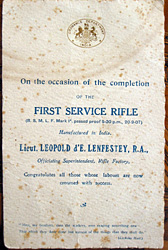 banquet menu cover Although I had and have many interests which give me a full life in retirement, I was once again attracted by the idea of tracing my family tree but I donft think that, at the beginning, I was prepared for the amount of work it entailed, or for the great interest it evoked or for the contacts I was to make with distant cousins in England and in some of the English-speaking countries of the former British Empire. At the outset, my idea was very simple, namely, to trace the male lines from my maternal and paternal grandfathers. I had photocopies of some documents, very valuable as it turned out, a cousin had given me some years before but, generally, I found that most of my relatives seemed to know very little about our immediate ancestors. All the uncles and aunts of my parentsf generation had died. For instance, none of my cousins knew that our common grandfather had been born in Canada. I knew where to look up births, deaths and marriages dating from 1837, because I had had occasion in the past to get a copy of my birth certificate and I was also aware of the existence of census returns that were available for every decade from 1841 to 1891. (Those of 1901 became available in 2001). I would go forth to the Family Records Office in Clerkenwell, central London, with a tiny notebook and pencil to copy down my results in what proved to be a most unsuitable manner. But, nevertheless, a new world opened to me. It was the first time in my life that I had undertaken research of such breadth and, though there are many books on how to carry out such work, time can be wasted and mistakes made but that is not always a disadvantage for I learnt a lot from my amateurish start. I realised that drastic action was necessary if the facts obtained from my research were not to get into a state of chaos. First, I needed to have a more disciplined way of recording my field discoveries, so I prepared sheets with all the headings necessary so as not to forget to put down important information when I was studying documents in the various records centres. Then, back home, I had to decide what information to use, how to collate it and in what form. The most crucial decision concerned the acquisition of a computer connecting me to the Internet, for it not only enabled me to use genealogy databases to record my research in a disciplined way but also put me in touch with many websites providing family history information. At the start, I did not know exactly how I would obtain details of my ancestors who lived before 1837, that is, prior to the introduction of the compulsory civil registration of births, marriages and deaths. Up to that date, the main records were kept by parish churches in their registers of baptisms, marriages and burials, usually dating from the middle of the 16th century. I at first thought that I should have to visit every town or village where my ancestors had lived to look at such archives. However, gradually, I learnt of the existence of two other centres in London and central records offices in each county, which hold parish records, and realised the value of joining a family history association. I also became a member of the Society of Genealogists, which holds a most valuable collection of material for the whole of the UK, plus a library of books relating to countries of the former British Empire. I thus found it necessary to plan in some detail my research days, so as to make the most efficient use of my time and apply some logical plan to my research. For example, decisions had to be made about which of the three main archive centres in central London I would use on a particular day or whether I should spend the time in Chelmsford in the county Essex for researching one branch of the family or in Dorchester in the county of Dorset for another. Once back home, the new information I had gathered might point to new research on one of the Internet sites or to the need to contact by E-mail people in New Zealand or America researching the same family line. (I describe below how I came to get in touch with these people.) a) My relatives 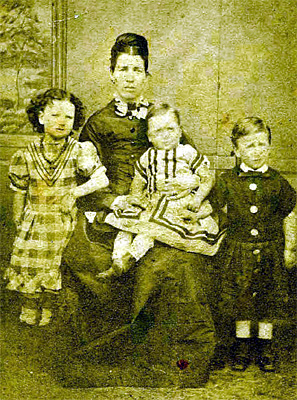 Photo of Mary Bullerwell and children: my grandfather is the child on the right My cousin also provided me with a copy of several documents such as the indenture for the 7-year apprenticeship of Mary Bullerwellfs husband, (John Bullerwell, one of my great-grandfathers) which he and his father George signed in 1854, when he was 14, at the start of his training to become a fitter at a famous locomotive factory in Newcastle in the north of England. 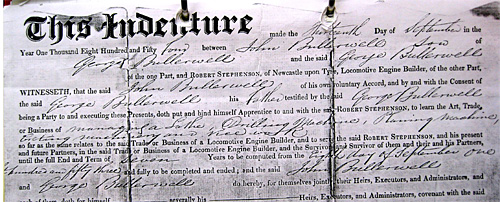 We see here the date the indent was drawn up (Sept 13 1854), the names of John and his father and the name of the locomotive builder. We see that John was to be trained in the use of lathes, drilling and planing machines and that the term of the apprenticeship would date from the previous year, (September 8 1853). The document is very long and goes into the details of hours of work, holidays, pay. I also got some important information from my brother. My father had left him the family bible that contained some interesting detail written inside the front cover. This enabled me to trace the family of the woman, Ellen Pharaoh, who married our great-grandfather. The bible had belonged to Ellenfs sister, Julia, who died in 1868 aged 42. Her family gave James and Ellen the bible in remembrance of Julia. 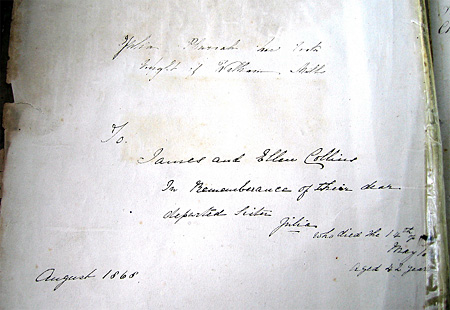 the handwriting tells us: Julia Pharaoh her book bought of William Mills to James and Ellen Collins in remembrance of their dear departed sister Julia who died on the 14th May 1868 aged 42. The entry dated August 1868 b) The Family Records Centre, London The first example is that of the birth certificate of John, mentioned above, who started his apprenticeship in 1854 as a fitter. I was able to locate his approximate date of birth from a copy of his death certificate given to me by a cousin. John died in 1915 aged 75. When I received a copy of the birth certificate, I learnt several interesting facts about his family at that time, as follows:
- The family lived in the new colliery village of East Murton, Co. Durham, NE England.
- John was born on 8 September 1839 - his father was called George Bullerwell, an innkeeper - his motherfs maiden name at her birth was Eleanor Thompson Railton Using the familyfs address, I was then able to find John and his family on the 1841 census. I learnt that he had four siblings and the ages of each member of the family The second example is that of
the marriage certificate of my other great-grandfather, James,
to Ellen Pharaoh, mentioned above.
This extract tells us that:
They were married on February 8 1858
James was 23, and Ellen 21 James was a gun maker They both lived in two different parishes in north-east London, several miles from the area their parents were known to be living The marriage took place at St Leonardfs, Shoreditch in north London Jamesfs father, William, was a ratcatcher, and George, Ellenfs father, was a leather dresser Jamesfs father, William, witnessed the marriage as did Ellenfs mother, Susanna. I have since learnt that her father, George had already died by 1858 The third example is that of a death certificate, that of William, the ratcatcher, mentioned above.
I learned the following from this document:
William died on 28th December 1883, aged 80
His occupation was vermin exterminator He died at his home address in Enfield Jane, his daughter, reported his death to the registrar. The doctor said that William had died of old age I think there is a mistake on this certificate for Jane was his daughter-in-law, his sonfs wife. The fourth example is that of a census. I have chosen the 1901 census entry for my maternal grandfather John Bullerwell.  1901 census Edmonton registration district, Enfield, Middlesex now part of Greater London (Crown copyright HMSO) I learned from entry 164 that:
My grandfather, John, was the head of the family, aged 30, born in Waltham, Herts, and worked as a blacksmith at a gun factory (called, as I knew, the Royal Small Arms Factory at Enfield)
His wife, Josephine, was 29, had been born in Camden Town, Middlesex They had one child at the time, a son, John, aged six, born in Enfield c) County and other local records/archives centre, where local pre-1837 parish records are found. Because of my familyfs origins I have used London Metropolitan Archives, which has parish and census records for Greater London, the Guildhall Library, London, which holds records for the administrative area known as the City of London, The Westminster City Archive, the Essex Records Centre at Chelmsford where records for the county of Essex are kept, the Dorset Archives at Dorchester in the county of Dorset. Such records are usually viewed on microfiche or microfilm. You can make photocopies of them if you wish but often the state of the records is so poor that it is only worth making a note of the details. From Westminster, I found a marriage certificate, which enabled me to able to clear up some confusion about the name of the woman getting married. It concerns the marriage in 1849 of Jane Izant Bullerwell, niece of my great-great-grandfather George Bullerwell, and James East, a French polisher. The details are of particular interest because an incorrect name is given for the womanfs birth on the IGI website (see section 9 below) where she is called Jane Grant Bullerwell.
The given information which is of interest here is:
Janefs full name was Jane Izant (not Grant) Bullerwell Her fatherfs name was not known but his surname is given as Bullerwell I was able to establish from other records that Jane was the illegitimate daughter of Jane Bullerwell, who subsequently married George Izant. So, daughter Jane used her stepfatherfs name and also kept her motherfs maiden name as her surname. She had been born in the north of England in 1826 where the Bullerwells had come from and her mother brought her down to London some time in the 1830s. This is another example of the errors that often occur in genealogy records. d) The Society of Genealogists For example, I found an alphabetical list of the names of marriages for Middlesex for the period April to June 1854, which some enthusiastic genealogist had written down by hand. It enabled me to establish that my ancestor Joseph Overall was born in Hackney and led me to the marriage register entry in the index at the Family Records Centre. I was thus able to get the marriage certificate and find the name of his wife. e) The Northumberland & Durham Family History Society
I joined this society, one of many around the country, because my motherfs family came from this part of the UK. The societyfs journal has proved very helpful for there I found:
the name of a professional local genealogist who provided me with a great deal of information
about my maternal line.
I also advertised a problem I wished to solve in the section of the journal where members may give the names of the ancestors they are looking for. I had an immediate response from a woman in New Zealand who is related to me 6 generations back. She had a lot more information to pass on to me and I to her and, what was even better, she linked me to almost a dozen other people tracing the same line. See f) below f) Internet Contact with my distant cousins living in the north of England, the USA, Canada, Australia and New Zealand with whom I am in Internet contact. We are all descended from the same Bullerwell couple who married in the middle of the 18th century in County Durham in north-east England. g) Chance remarks made when meeting friends and archivists have produced some very valuable material for me. For example, I am very indebted to the Enfield archivist who talked to me about my ratcatcher ancestor, mentioned above and below, where I explain the title of my account of my family history. That archivist also showed me a register of boys who started at a school near where the ratcatcher lived. The register dates from the 1830s and there I found entries for four of the ratcatcher's boys - William, George, James (my great-grandfather) and Stephen. Each entry gives the date the boy started school, their home address, age fatherfs occupation and sometimes what happened to them in later years or their occupation. 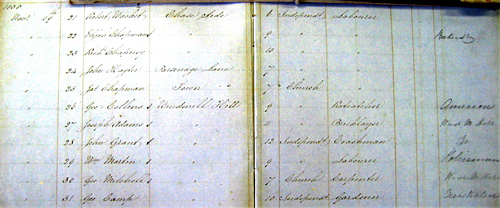
Here we have the following details:
Entries for 19th November1838
The 26th pupil on the school list George Collins aged 7, Jamesfs brother gChurchh means that he had been baptised into the Church of England (though this school was run by Nonconformists - you can see some boys are called Independent) He lived on Windmill Hill (where I learnt later his father kept a public house) The headmaster has written AMERICA in the last column. For the first three of the ratcatcherfs boys, the headmaster wrote America. I suppose that refers to my ancestorfs stay in Canada where my grandfather was born. I did not know before that two of Jamesfs brothers had gone there also. h) IGI-the international genealogical index on Internet The IGI is an enormous database of church registers dating back, in the case of the UK, to the middle of the 16th century. This has been prepared by the Church of Jesus Christ of Latter Day Saints, Utah, USA. It is particularly useful for births/baptisms and marriages. Searches are conducted by entering at least a name. I have constantly referred to it in the past and recently the 1881 British census has been added to it. The IGI website is one of the first sources that British genealogists consult for people for births and deaths sof people living before 1900. I have so far traced my principal maternal and paternal lines back to the beginning of the 18th century, noting all the siblings of husband and wife of each couple as well as their children. However, I am at the moment unable to get beyond 1850 with some branches. The genealogy programme on my computer enables me to print out reports on various lines of the family tree. Obviously, I have much more information about my 19th century ancestors than those of the previous century, since the laws on the civil registration of births, deaths, marriages and the details required by the census of each decade give a more precise picture of the families, where they lived, their jobs and illnesses. As I was asked to write about my family history, I was thus given the opportunity to put all my facts into readable form, which may be of interest to my young relatives. I gave it the title gRatcatchers and Riflesh. I will explain the title. First, why Ratcatchers? My great-great grandfather William Collins (1803-1883) was a ratcatcher and for some time ran a public house. I had great difficulty in tracing this ancestor but his discovery came about in the most amazing way, thanks to a very knowledgeable archivist. I knew only the name and that he was the father of my great-grandfather James. I went to the local archive office in Enfield to look up my fatherfs family on the censuses. When the archivist heard the name, he said gThat must be William Collins the ratcatcher,h and he showed me an article about the ratcatchers of Enfield. He then said that he thought this same man was the landlord of a pub in Enfield and showed me a book on local pubs and there we found an article and drawing of gThe Old Wheatsheafh run by William - a pub that still exists and in which I have had lunch on two occasions. Why Rifles? The research showed me how the lives of my ancestors in the 19th and 20th centuries were affected by the development of the industrial revolution and the British Empire - fitters trained in a locomotive factory in northern England found work in a rifle factory in the south. There, two great-grandfathers (including the ratcatcherfs son), two grandfathers and some of their brothers earned their living. There, George and William Collins, the brothers of my great-grandfather James, did part of their military training at the beginning of the 1850s before joining Guards regiments with whom they were sent to Canada at the end of 1861 at a time when there was some tension between Great Britain and the USA resulting from the American Civil War. Also in that factory, my father, his brother and their brother-in-law did some arms training and began their army careers. This led to their service in India and elsewhere. Thus, I was destined to live in countries far from England, all because of the manufacture of rifles and the development of those countries in the 21st century remains of great interest to me. |